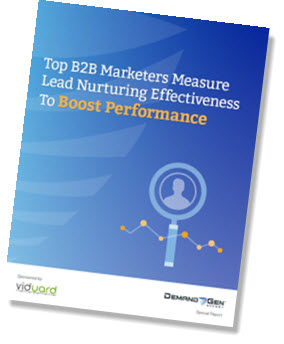Demand Gen Report just published “Top B2B Marketers Measure Lead Nurturing Effectiveness to Boost Performance,” a special report in which they address the whys, whats, and how tos of measuring lead nurturing’s true impact. You can download a free copy of the report here.
 According to Demand Gen Report’s own demand generation benchmark study, roughly 40 percent of B2B marketers aren’t sure how their lead nurturing programs are performing. This new report shares insights, ideas, best practices, and real-life examples of how to measure lead nurturing performance beyond basic email metrics like open and click rates. It’s a useful reference for any marketer tasked with measuring the impact, and therefore the ROI, from lead nurturing and enabling technology like marketing automation.
According to Demand Gen Report’s own demand generation benchmark study, roughly 40 percent of B2B marketers aren’t sure how their lead nurturing programs are performing. This new report shares insights, ideas, best practices, and real-life examples of how to measure lead nurturing performance beyond basic email metrics like open and click rates. It’s a useful reference for any marketer tasked with measuring the impact, and therefore the ROI, from lead nurturing and enabling technology like marketing automation.
I was flattered to be asked to contribute to the report, and my contribution is reproduced below, reposted here with permission:
First of all, let’s define lead nurturing success. In our firm’s marketing automation practice, we define success not as email clicks, response rate, or even overall engagement, but instead: clear, demonstrated, and attributable movement of leads through the lead lifecycle – for example, inquiry to MQL, MQL to SAL, and so on. That, ultimately, is what lead nurturing is designed to do – move leads towards opportunity and close.
A first step is typically benchmarking a client’s current metrics. Most of our clients follow the SiriusDecisions waterfall model (MQL, SQL, etc.), and when we first engage we like to know their current conversion metrics, for example:
• percentage of raw inquiries that convert to MQL
• percentage of MQLs that convert to SQL
… and so on. This exercise does two things: it allows us to 1) compare those metrics to accepted industry standards, and 2) identify any specific issues or bottlenecks. For example, if a company’s Lead-to-MQL rate is lower than it should be, that could mean several things:
1. the company is generating the wrong type of leads
2. the company is doing a poor job nurturing and following up with raw inquiries
3. the company’s definition for MQL is too stringent
#1 is a top-of-the-funnel, lead generation problem. #2 is something that can easily be addressed via more systematic, structured nurturing of new leads. (Coincidentally, it’s at this very early stage where we see automated lead nurturing have the most positive impact.)
#3 is an example of a common challenge in measuring lead nurturing, namely that the precise definition for each stage can vary from one company to the next. The closer those definitions map to industry standards the better, because that makes it easier to gauge where the lead journey may be breaking down.
But, more important is having clear, precise definitions for each stage – whatever those definitions are – that both marketing and sales buy into. If leads are being converted to MQLs, for example, without much regard to status or qualification simply because someone in Inside Sales feels that’s his/her job (i.e. to convert leads), then the underlying data will be suspect from Day One.
Recently, we were engaged by a large IT services company to address what they felt was the low rate at which raw leads were converting to qualified leads, opportunities and deals. We audited their lead management process from end-to-end and recommended a few key changes:
• revamping email creative to better adhere to best practice standards
• implementing a lead nurturing campaign at the very front end of the qualification process, to complement telemarketing follow-up by inside sales
• developing a nurture campaign specifically designed for “mid-stage” leads; and lastly
• creating segmented nurturing tracks tailored to the client’s key buying personas
The results were dramatic. Email open rates increased more than 260 percent, click rates more than doubled, and the Lead to MQL conversion rate for online programs such as content syndication, banner ads, SEM, Webinars, etc. increased a massive 75 percent.
For more tips on increasing the effectiveness of lead nurturing, download our free white paper: “Top 10 Tips for Lead Nurturing Success.”

It is surprising to learn that 40% of B2B marketers don’t know how their lead nurturing programs are going. Companies need to know the effectiveness of their lead nurturing programs. This data helps to not only establish an ROI but to identify areas of opportunity, or at least, shed a light on areas that could use some improvement.